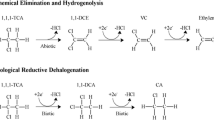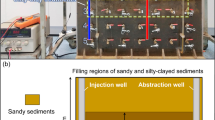Abstract
An initial assessment of an old manufacturing site with groundwater impacted by trichloroethene (TCE) contamination in the metropolitan New York area showed that the TCE was being removed naturally by reductive dechlorination. However, complete dechlorination was not expected at the site because the process was progressing too slowly under transitional to aerobic conditions at a degradation constant of −0.0013 and a TCE half life of 533 days. A pilot test was conducted at the site in which a carbohydrate substrate (molasses) was injected into the groundwater to create an In-Situ Reactive Zone (IRZ). Post-pilot test groundwater sampling and analysis indicated that an IRZ was created successfully as the total organic carbon (TOC) content and conductivity increased significantly while oxidation-reduction (REDOX) potential and dissolved oxygen (DO) decreased. The created IRZ caused enhanced reductive dechlorination of TCE at the site, found to proceed with a degradation constant of −0.0158 and a TCE half life of 44 days.









Similar content being viewed by others
References
Azadpour-Keeley A, Keeley JW, Russel HH, Sewell GW (2001) Monitored natural attenuation of contaminants in the subsurface: processes. Ground Water Monit R 21:97–107
Ballapragada BS, Stensel HD, Puhakka JA, Ferguson JF (1997) Effect of hydrogen on reductive rechlorination of chlorinated ethenes. Environ Sci Tech 31:1728–1734
Bouwer EJ, McCarty PL (1983) Transformations of 1- and 2-carbon halogenated aliphatic organic compounds under methanogenic conditions. Appl Envir Microbiol 45:1286–1294
Carr CS, Hughes JB (1998) Enrichment of high-rate PCE dechlorination and comparative study of lactate, methanol, and hydrogen as electron donors to sustain activity. Environ Sci Tech 32:1817–1824
Carr CS, Sanjay G, Hughes JB (2000) Effect of dechlorinating bacteria on the longevity and composition of PCE-containing nonaqueous phase liquids under equilibrium dissolution conditions. Environ Sci Tech 34:1088–1094
Delvin JF, McMaster M, Barker JF (2002) Hydrogeologic assessment of in situ natural attenuation in a controlled field experiment. Water Resour Res 38(1):3-1–3–11
de Bruin WP, Kotterman MJ, Posthumus MA, Schraa G, Zehnder AJ (1992) Complete biological reductive transformation of tetrachloroethene to ethane. Appl Envir Microbiol 58:1996–2000
DiStefano TD, Gossett JM, Zinder SH (1991) Reductive dechlorination of high concentration of tetrachloroethene to ethane by an anaerobic enrichment culture in the absence of methanogenesis. Appl Envir Microbiol 57:2287–2292
DiStefano TD, Gossett JM, Zinder SH (1992) Hydrogen as an electron donor for dechlorination of tetrachloroethene by an anaerobic mixed culture. Appl Envir Microbiol 58:3622–3629
Driscoll FG (1986) Groundwater and wells. Johnson Filtration Systems, St. Paul, Minnesota, 1089 pp
Fathepure BZ, Nengu JP, Boyd SA (1987) Anaerobic bacteria that dechlorinate perchloroethene. Appl Envir Microbiol 53:2671–2674
Fennell DE, Gossett JM, Zinder SH (1997) Comparison of butyric acid, ethanol, lactic acid, and propionic acid as hydrogen donors for the reductive dechlorination of tetrachloroethene. Environ Sci Tech 31:918–926
Freedman DL, Gossett JM (1989) Biological reductive dechlorination of tetrachloroethylene and trichloroethylene to ethylene under methanogenic conditions. Appl Envir Microbiol 55:2144–2151
Gerritse J, Renard V, Gomes TMP, Lawson PA, Collins MD, Gottschal JC (1996) Desulfitobacterium sp. strain PCE1, an anaerobic bacterium that can grow by reductive dechlorination of tetrachloroethene or ortho-chlorinated phenols. Arch Microbiol 165:132–140
Hall LM (1968) Bedrock geology in the vicinity of White Plain, New York. University of Massachusetts, Amherst, Massachusetts
Holliger C, Schumacher W (1994) Reductive dehalogenation as a respiratory process. Antonie van Leeuwenhoek 66:239–246
Holliger C, Schraa G, Stams AJ, Zehnder AJ (1993) A highly purified enrichment culture couples the reductive dechlorination of tetrachloroethene to growth. Appl Envir Microbiol 59:2991–2997
Krumholz LR, Sharp R, Fishbain SS (1996) A freshwater anaerobe coupling acetate oxidation to tetrachloroethylene dehalogenation. Appl Envir Microbiol 62:4108–4113
MacDonald J (2000) Natural attenuation for groundwater cleanup. Environ Sci Technol 34:346A-353A
Maymó-Gatell X, Chien Y-t, Gossett JM, Zinder SH (1997) Isolation of a bacterium that reductively dechlorinates tetrachloroethene to ethane. Science 276:1568–1571
Morse JJ, Alleman BC, Gossett JM, Zinder SH, Fennell DE, Sewell GW, Vogel CM (1998) A treatability test for evaluating the potential applicability of the reductive anaerobic biological in situ treatment technology (RABITT) to remediate chloroethenes – DRAFT. Department of Defense, Environmental Security Technology Certification Program, Arlington, Virginia
Sharma PK, McCarty PL (1996) Isolation and characterization of a facultatively aerobic bacterium that reductively dehalogenates tetrachloroethene to cis-1,2-Dichloroethene. Appl Envir Microbiol 62:761–765
Smatlak CR, Gossett JM, Zinder SH (1996) Comparative kinetics of hydrogen utilization for reductive dechlorination of tetrachloroethene and methanogenesis in an anaerobic enrichment culture. Environ Sci Tech 30:2850–2858
Sutherson SS (1997) Remediation engineering, design concepts. CRC Press, Boca Raton, Florida
Sutherson SS (2002) Natural and enhanced remediation systems. CRC Press, Boca Raton, Florida
U.S. Environmental Protection Agency (1993) Evaluation of the likelihood of DNAPL presence at NPL sites. EPA 540-R-93–073, U.S. EPA, Office of Solid Waste and Emergency Response, Washington, DC
U.S. Environmental Protection Agency (1998) Groundwater sampling standard operating procedures. U.S. Environmental Protection Agency, Region II, New York
Vogel T, McCarty PL (1985) Biotransformation of tetrachloroethylene to trichloroethylene, dichloroethylene, vinyl chloride, and carbon dioxide under methanogenic conditions. Appl Envir Microbiol 49:1080–1083
Wiedemeier TH, Wilson JT, Kampbell DH, Miller RN, Hansen JE (1995) Technical protocol for implementing intrinsic remediation with long-term monitoring for natural attenuation of fuel contamination dissolved in groundwater (volumes I and II). San Antonio, Texas: Air Force Center for Environmental Excellence Technology Transfer Division, Brooks AFB
Wiedemeier TH, Swanson MA, Moutoux DE, Gordon EK, Wilson JT, Wilson BH, Kampbell DH, Hansen JE, Haas P, Chapelle FH (1996) Technical protocol for evaluating natural attenuation of chlorinated solvents in groundwater. Air Force Center for Environmental Excellence, Technology Transfer Division, San Antonio, Texas
Wiedemeier TH, Rifai HS, Newell CJ, Wilson JT (1999) Natural attenuation of fuels and solvents in subsurface. Wiley, New York, 632 pp
Author information
Authors and Affiliations
Corresponding author
Rights and permissions
About this article
Cite this article
Rodriguez, E., McGuinness, K.A. & Ophori, D.U. A field evaluation of enhanced reductive dechlorination of chlorinated solvents in groundwater, New York Metropolitan Area. Env Geol 45, 623–632 (2004). https://doi.org/10.1007/s00254-003-0920-0
Received:
Accepted:
Published:
Issue Date:
DOI: https://doi.org/10.1007/s00254-003-0920-0




